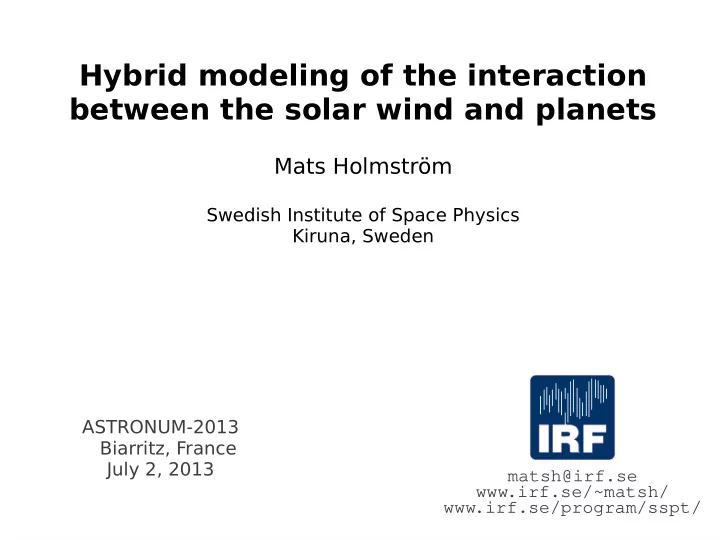

Hybrid modeling of the interaction between the solar wind and planets Mats Holmström Swedish Institute of Space Physics Kiruna, Sweden ASTRONUM-2013 Biarritz, France July 2, 2013 matsh@irf.se www.irf.se/~matsh/ www.irf.se/program/sspt/
Outline ● A general model for the interaction between planets and the solar wind ● Applications ● Effects of Lunar surface absorption ● Lunar wake currents
Model features ● A general hybrid solver for plasmas has been developed (hybrid = fluid electrons and ions as particles) ● It is part of the public FLASH software from University of Chicago. Parallel, adaptive grid. We use cluster with 15456 cores at the High Performance Computing Center North (HPC2N) in Umeå, allowing for giga-particle simulations and fast running times (hours) ● The model handles time dependent simulations, arbitrary internal resistivity profiles (conducting core and mantle), ● Surface relected ions ● Arbitrary permanent magnetic fields can be handled (dipole, or magnetic anomalies ● Chapman ionospheric production
Hybrid field equations
Vaccum in a Hybrid Model ● Solution proposed in the 70's by Harned, and by Hewit: High resistivity in vacuum regions => solve Laplace equation ● Not so easy to solve Laplace on an irregular, time varying domain. Instead, Faraday's Law gives a diffusion equation
Resistivity implementation ● The logic is ● if cden<cmin # in obstacle or vacuum cden_inv = 0 if outside obstacle # vacuum res = res_vacuum ● We can have an arbitrary resistivity profile inside the obstacle
Vaccum resistivity
Moon-Solar Wind Interaction The Earth’s Moon: no global magnetic field, no atmosphere, without conductivity. => ideal case for modeling. Solar wind impacts the Moon and is absorbed => plasma void Ions and electrons refill the wake (thermal expansion)
Motivation How much does the lunar surface plasma absorption affect the proton velocity distributions in the lunar wake?
Methodology • Hybrid model [Holmström, 2010] • Backward Liouville method [Fatemi et al., 2012] [Futaana et. al., 2010]
Phase space density f/f 0 f/f 0 [Fatemi et al., JGR, 2012]
Moments of the distributions Maxwellian Bi-Maxwellian R = T ⊥ / T || − 1 [Fatemi et al., JGR, 2012]
Summary: Surface Absorption This first application of the Backward Liouville method for PIC provides high velocity space resolution. The lunar plasma surface absorption effect is very strong for the near lunar wake. The Moon as a solar wind plasma absorber can change the proton moments and produce proton temperature anisotropies in the near lunar wake.
Magnetic fields from hybrid simulations Magnetic fields from hybrid simulations IMF IMF SW SW IMF IMF SW SW
Lunar wake current Lunar wake current Ampere’s law J = ∇ × B µ 0 [Owen et al., GRL 1996]
IMF anti-parallel to the solar wind IMF anti-parallel to the solar wind
IMF anti-parallel to the solar wind IMF anti-parallel to the solar wind
IMF perpendicular to the solar wind IMF perpendicular to the solar wind
IMF perpendicular to the solar wind IMF perpendicular to the solar wind 8
Currents: Summary Currents: Summary [Fatemi et al., GRL 2013]
Ongoing work ● Rhea and Callisto plasma interactions ● Time dependent effects of internal Lunar conductivity ● Mars and Venus ● Mercury
The End
Recommend
More recommend